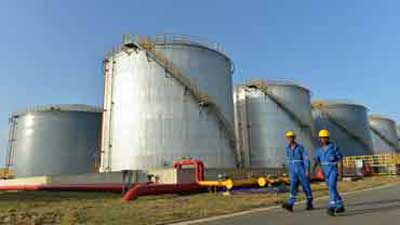Wednesday Feb 26, 2025
Wednesday Feb 26, 2025
Saturday, 22 August 2015 00:00 - - {{hitsCtrl.values.hits}}

Reuters - Sri Lanka’s Ceylon Petroleum Corp (Ceypetco) is seeking Murban crude oil term cargoes for the first time, after buying the oil in the spot market recently, industry sources said on Thursday.
Sri Lanka was a regular importer of Iranian oil until Western sanctions were imposed in 2012, when Colombo sharply reduced its purchases of crude from the country and later switched to spot imports of Oman light and Murban crude oil.
“There has been a change in the refinery process and it’s now more profitable for (Ceypetco) to buy Murban crude oil,” one of the sources close to the matter said.
“There is a higher yield of value-added oil products like middle distillates and gasoline and the sulphur is low.”
The company is still mulling if it will permanently switch to Murban crude oil imports, but for now will meet its requirements through the term contract, the source added.
In the term tender, Ceypetco is seeking 10 cargoes of 700,000 barrels each of Murban crude oil for delivery into its single point buoy mooring 1 in Colombo, according to one of the sources.
The cargoes are to be delivered over 1 December 2015 to 31 July 2016.
The tender closes on Sept. 2 and is valid for six weeks.
Ceypetco has requested the cargoes be loaded from either Jebel Dhanna or Fujairah in the United Arab Emirates.
Crude oil similar or identical to Iranian crude oil will not be permitted, according to a tender document. Loading ports under US sanctions will also not be accepted.
Sri Lanka’s only oil refinery - a decades-old, 50,000 barrels-per-day (bpd) plant run by Ceypetco - is configured to run on Iranian crude. The Sapugaskanda refinery, near Colombo, has faced closure at times as it scrambled to fill shortfalls due to the sanctions on Iranian oil.
Sri Lanka has been importing Oman light and Murban crude from Abu Dhabi, but Ceypetco officials previously said that the yield at the refinery from processing these alternative crudes had been 15-20 percent lower than that from Iran light.
It is not clear by how much the yield has improved since then.
Discover Kapruka, the leading online shopping platform in Sri Lanka, where you can conveniently send Gifts and Flowers to your loved ones for any event including Valentine ’s Day. Explore a wide range of popular Shopping Categories on Kapruka, including Toys, Groceries, Electronics, Birthday Cakes, Fruits, Chocolates, Flower Bouquets, Clothing, Watches, Lingerie, Gift Sets and Jewellery. Also if you’re interested in selling with Kapruka, Partner Central by Kapruka is the best solution to start with. Moreover, through Kapruka Global Shop, you can also enjoy the convenience of purchasing products from renowned platforms like Amazon and eBay and have them delivered to Sri Lanka.
Discover Kapruka, the leading online shopping platform in Sri Lanka, where you can conveniently send Gifts and Flowers to your loved ones for any event including Valentine ’s Day. Explore a wide range of popular Shopping Categories on Kapruka, including Toys, Groceries, Electronics, Birthday Cakes, Fruits, Chocolates, Flower Bouquets, Clothing, Watches, Lingerie, Gift Sets and Jewellery. Also if you’re interested in selling with Kapruka, Partner Central by Kapruka is the best solution to start with. Moreover, through Kapruka Global Shop, you can also enjoy the convenience of purchasing products from renowned platforms like Amazon and eBay and have them delivered to Sri Lanka.